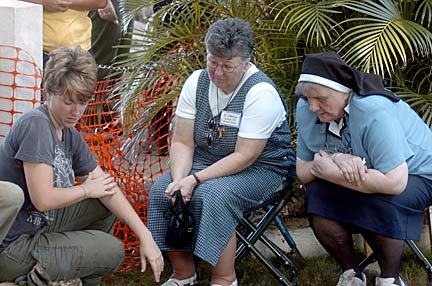
|
Exhumation of nun
becomes a learning
experience
KALAUPAPA, Molokai » An archaeological dig that drew residents and visitors to the grave of an historic caregiver and spiritual leader here is expected to be completed today.
The exhumation of the body of Mother Marianne Cope drew more than 100 spectators for a rare opportunity to watch scientific experts discover and delicately extract bones, crucifixes, coffin nails and other artifacts from the 1918 burial site.
People leaned over the open grave to watch the work under way 8 feet down. But the Franciscans mandated that no photographs were to be taken of the bones. The fragile pieces were bagged and carried to the nearby convent where the laundry room served as a temporary forensic laboratory.
Spectators became engaged in the event. The dig, which began Sunday, became an introductory archaeology course as Vincent Sava and his team of archaeologists, anthropologists and forensic experts answered questions as they worked and described what they found.
It was also a teaching -- and learning -- experience for 20 members of the Sisters of St. Francis who anticipate that the 19th-century nun will be named a saint by the Catholic Church. People who weren't asking them questions -- why keep bones, what are relics -- were bent on telling a sister about their life in the settlement where Cope cared for leprosy victims for 30 years, or their experiences with nuns, nurses, saints and bones. One frequent answer: Exhumation is required by the church before Cope is declared "blessed" later this year in the second of three steps in the sainthood process.

The Rev. Thomas Gross prayed on Monday for the volunteers for their expertise during the excavation of Mother Marianne Cope's grave at Kalaupapa, Molokai.
He has worked in heavy labor jobs, including as gravedigger, since he was sent there at the age of 19. He and other former patients eventually won a political struggle to be credited for their work, be given civil service status and the right to a state pension.
"I think it's good for people to have a chance to see her," Kahilihiwa said. He said he got over initial resentment that Cope's remains will be returned to the Syracuse, N.Y., headquarters of the religious order. "I know she's with us anyway," he said.
"I don't think of myself as sentimental," said Dr. Paul DeMare. The sight of human bones is not new to the Honolulu radiologist, but in this case, "I found myself taking a personal, not clinical, interest, more so than I expected." He is the great-great-grandnephew of Cope, a connection he learned about only when, as an intern 35 years ago, he visited Kalaupapa and later described the experience to relatives in upstate New York.
He will underwrite copies of a videotape of the excavation and interviews at the scene filmed by his colleague, Dr. Richard Gould, for Franciscans who weren't there.
A metal crucifix found yesterday morning was seen as a particular treasure because it was found near the ribs, something Cope would have worn over her heart. The design includes a skull and crossbones at the foot of the cross.
"It was always a reminder that this is a finite life, to keep your sights on a bigger picture," said Sister Patricia Burkhart, general minister of the Sisters of St. Francis. "Many saints meditated on it."
Besides artifacts, the sisters gathered several plastic bags of soil from the grave. They will also be carried to Syracuse. When a shrine is built, the metal container holding Cope's bones will rest on Kalaupapa soil.
The Franciscans fed up to 60 people daily during this busy week in the dining room of Bishop Home, the convent where Cope shared meals with her sisters a century ago. No one at the table -- priests, nuns, doctors, guests, journalists -- was ignorant of that link.
[News] [Business] [Features] [Sports] [Editorial] [Do It Electric!]
[Classified Ads] [Search] [Subscribe] [Info] [Letter to Editor]
[Feedback]
